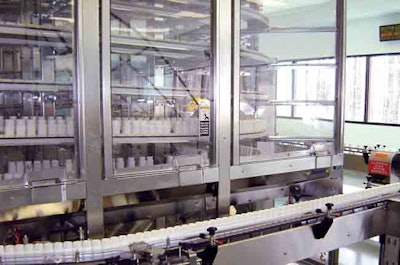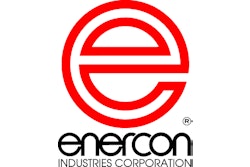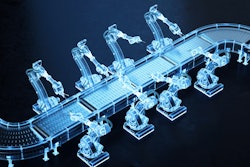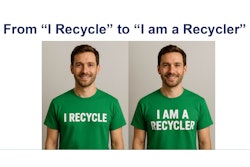AstraZeneca's online mission statement says that its people are dedicated to discovering, developing, and delivering innovative pharmaceutical solutions. The company's Newark, DE, plant proves that the company's mission extends beyond product research and development into its packaging operations.
Last year the facility added a Hartness (www.hartness.com) Dynac 6400 system to boost efficiency between a capper and labeler on Line 4, which fills tablets into 75-cc white opaque high-density polyethylene bottles from O-I (www.o-i.com).
By adding the Dynac system, AstraZeneca's post-installation line analysis showed a significant improvement in Overall Equipment Effectiveness (OEE). OEE is determined through a mathematical formula involving three ratios: equipment availability, material quality, and performance. For more details on OEE, visit www.sixsigma.com).
Before adding the Dynac, “the spacing between the equipment was not sufficient for the 325-bottle-per-minute speed we need to run,” says AstraZeneca project manager Dave Mason. In the past, the line experienced frequent stops during the day, which reduced efficiency due to a lack of consistent bottle flow between the equipment.
In an effort to improve bottle flow on Line 4, Mason explains that company representatives looked to the cosmetics business.
“We were looking for efficient equipment, and the cosmetics industry is more into OEE than the pharmaceutical business. Their equipment is more reliable,” he says. “Pharmaceuticals are getting there, but we lag behind other industries,” where efficiency is concerned.
Pricing structures have a lot to do with it, says Mason. For example, the profit on a bottle of aspirin is higher than on a bottle of juice. Consequently, he observes, the pharmaceutical market hasn't needed to focus on packaging efficiency as much as other industries.
But that's changing, particularly at AstraZeneca. “I know other pharmaceutical companies are talking about OEE, and have hired consultants out of other industries,” says Mason. “AstraZeneca is saving money by being more efficient and making sure we utilize our assets correctly.”
Based in London, the company's U.S. headquarters are in Wilmington, DE. AstraZeneca is a major international healthcare business and maker of prescription pharmaceuticals and supplier of healthcare services.
Following the flow
Line 4 runs five days a week, on two 10-hour shifts. Bottles proceed through an Omega (www.omegadesign.com) unscrambler, an Aylward (www.aylward-usa.com) tablet filler, Lock (www.lockinspection.com) metal detector, Enercon (www.enerconind.com) induction sealer, and then the Dynac unit before downstream labeling, case packing, palletizing, and distribution functions.
A Dynac system can be built in nearly 30 configurations, housing from three to nine tiers, depending on container height. AstraZeneca uses a four-tier system that provides eight minutes of accumulation for the 75-cc bottles. Its footprint, at 8.4-sq meters (90 sq'), is very compact.
“The Dynac system controls the bottle spacing in a first-in, first-out operation,” says Mason. It uses two parallel, but independently operated conveyors. One serves as the infeed, the other as an outfeed. Between the two is a transfer device referred to as a “spider.” It transfers product from infeed to outfeed. A mechanical device, the spider is driven by the movement of conveyors, reacting to differences in their speed.
‘Spider' is significant
If the outfeed conveyor slows or stops, the spider device is pulled in the direction of the faster moving infeed, and containers are accumulated on both conveyors in the process. Product is de-accumulated when the outfeed resumes and runs at a faster rate than the infeed conveyor.
In typical operation, the Dynac is empty. Bottles flow into the base of the machine and are immediately discharged. That reduces bottle transit time and allows for the first-in, first-out operation. Alpine conveyors, by comparison, typically remain full on the line.
The Dynac improves efficiency of Line 4 since its infeed conveyor is dedicated to the upstream induction sealer while the outfeed of the Dynac is dedicated to the downstream Weiler Labeling Systems (www.weilerls.com) labeler. The differences between the two conveyors are automatically compensated for by the spider. The resulting accumulation provides constant buffering of the 75-cc bottles without extensive control logic. Because the infeed and outfeed conveyors act independently, Dynac isolates their critical functions so that each can run on its own. The elimination of system interdependence improves line startup as machines can operate at disparate speeds. Upstream of the buffer system, Mason says the line runs at 325 bpm. Improvements in downstream equipment enable the line to run at speeds to 385/min.
Buffer benefits
One of the most important benefits of the Dynac is that it precisely spaces or meters the bottles based on downstream equipment needs. If AstraZeneca's labeler operates most efficiently with a 2” gap between bottles, for example, the Dynac can deliver bottles to it with that gap, regardless of how the upstream induction sealer delivers them to the Dynac.
Another benefit, Mason says, was the result of AstraZeneca “working closely with Hartness on purge issues and cleaning.” By purging, he explains, “Once the line's done, you look to clean up tablets or fallen bottles or caps before starting back up. If a bottle falls or if a cap doesn't go on and it gets past our inspection systems, it falls right down all the way to the trays at the bottom of the system.
“The reason that we put in the Dynac in August 2005 was to increase the OEE of the line,” recalls Mason. “And it's done that.”
John McTaggart, an AstraZeneca controls and engineering technician, was pleased when the post-installation line analysis showed an OEE of approximately 50%. “After working with Hartness and installing the Dynac, it was easy to see the benefits of the Dynac and the Hartness line-balancing theory.”
Mason believes the Dynac system employed by AstraZeneca is the “first one in the pharmaceutical industry.” He is so satisfied with the Dynac system that he says the company “is getting ready to buy another one for another line at the Newark plant,” which operates four bottle lines.
In this instance, AstraZeneca learned that by looking outside of the pharmaceutical industry, it found the Rx for its own tablet filling line.
—Jim Butschli
































